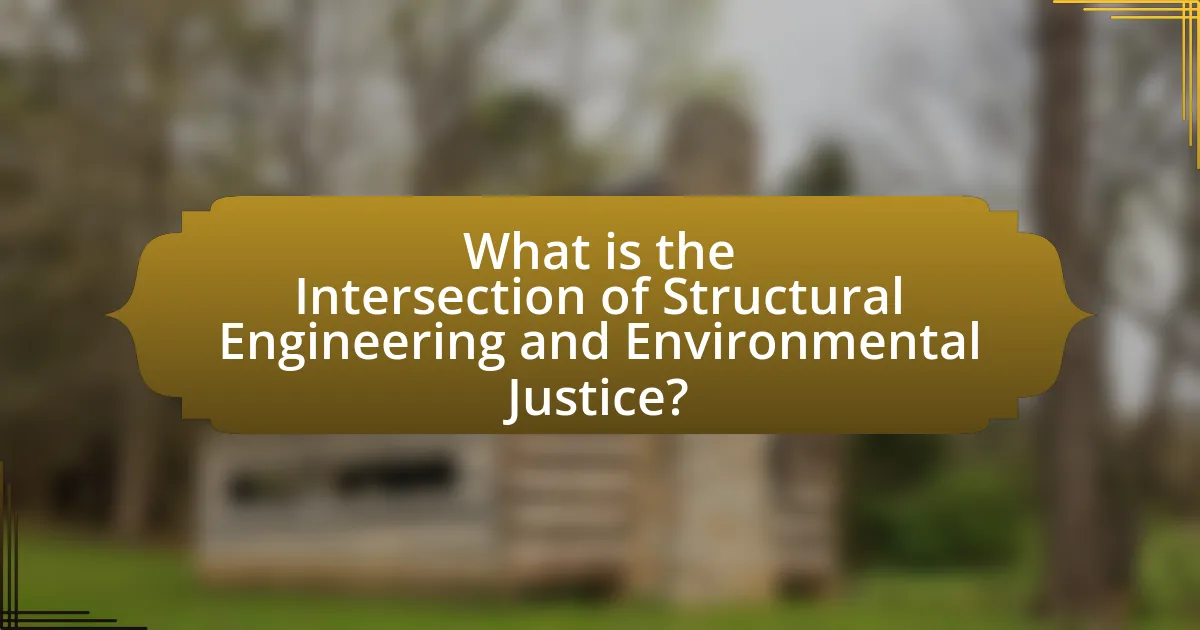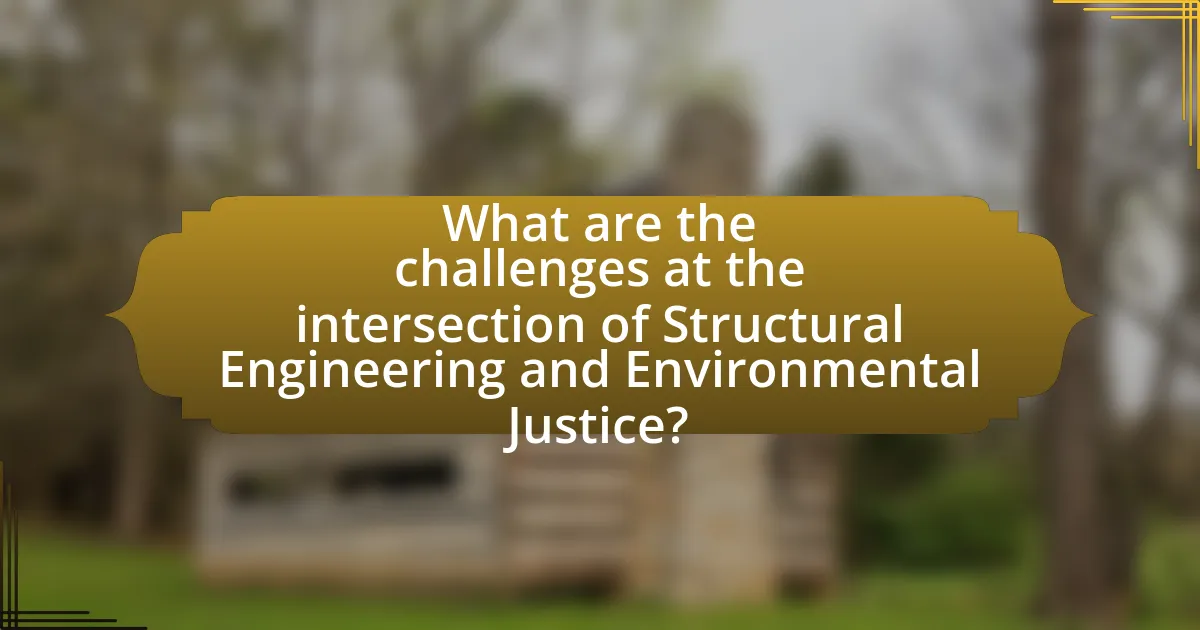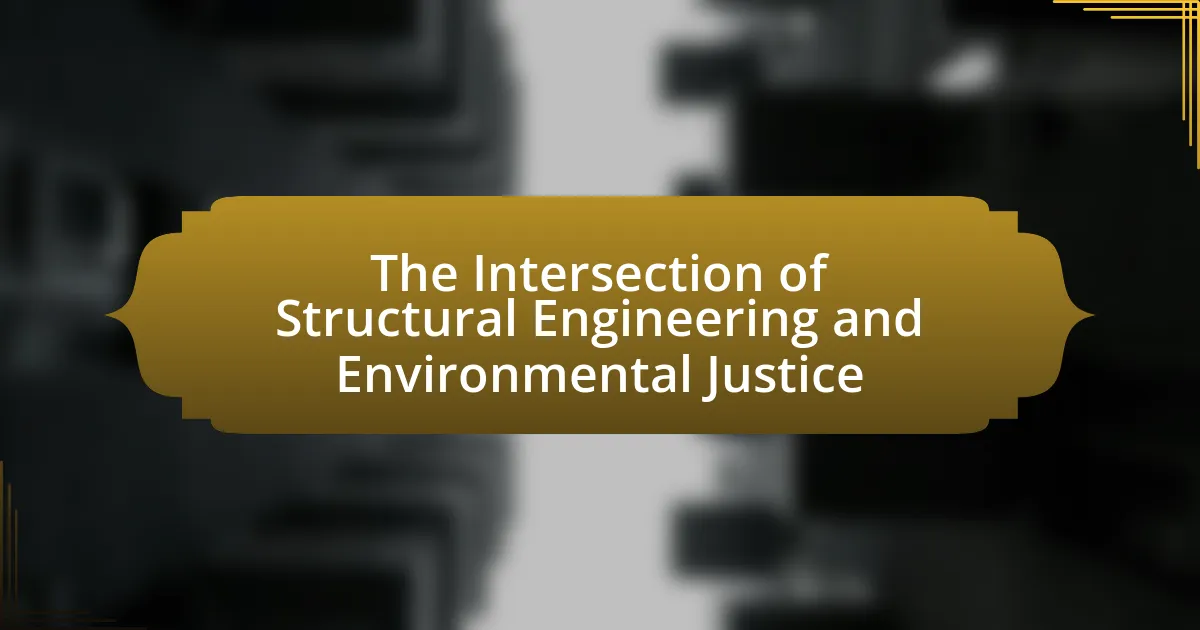The article examines the intersection of structural engineering and environmental justice, highlighting the importance of equitable design practices that address the needs of marginalized communities while ensuring structural integrity and sustainability. It discusses how structural engineering decisions impact environmental justice by influencing the distribution of environmental benefits and burdens, particularly in low-income and minority areas. Key principles relevant to this intersection include sustainability, equity in resource distribution, and community engagement. The article also outlines the historical context of environmental justice in engineering, the challenges faced in integrating these principles, and the role of policy and education in promoting social equity within engineering practices. Additionally, it emphasizes the need for community involvement and data-driven methodologies to enhance the effectiveness of engineering projects in addressing environmental justice concerns.

What is the Intersection of Structural Engineering and Environmental Justice?
The intersection of structural engineering and environmental justice involves the integration of equitable design practices that address the needs of marginalized communities while ensuring structural integrity and sustainability. Structural engineers play a crucial role in creating infrastructure that not only meets safety standards but also considers the social and environmental impacts on vulnerable populations. For instance, projects that prioritize affordable housing and resilient infrastructure in low-income areas exemplify this intersection, as they aim to reduce disparities in access to safe and healthy living conditions. Studies have shown that equitable infrastructure development can lead to improved public health outcomes and economic opportunities for disadvantaged groups, reinforcing the importance of aligning engineering practices with principles of environmental justice.
How do structural engineering practices impact environmental justice?
Structural engineering practices significantly impact environmental justice by influencing the distribution of environmental benefits and burdens across different communities. These practices determine the design, location, and materials used in infrastructure projects, which can either mitigate or exacerbate environmental hazards in marginalized areas. For instance, studies have shown that low-income and minority communities often face higher exposure to pollutants due to the placement of infrastructure such as highways and industrial facilities, which structural engineers design. According to the U.S. Environmental Protection Agency, communities of color are disproportionately affected by environmental hazards, highlighting the need for equitable engineering practices that prioritize the health and safety of all populations.
What are the key principles of structural engineering relevant to environmental justice?
The key principles of structural engineering relevant to environmental justice include sustainability, equity in resource distribution, and community engagement. Sustainability in structural engineering emphasizes the use of materials and methods that minimize environmental impact, such as reducing carbon footprints and promoting energy efficiency. Equity in resource distribution ensures that all communities, particularly marginalized ones, have access to safe and resilient infrastructure. Community engagement involves actively involving local populations in the planning and decision-making processes, ensuring that their needs and concerns are addressed. These principles are essential for creating structures that not only meet engineering standards but also promote social and environmental equity.
How does structural engineering contribute to equitable resource distribution?
Structural engineering contributes to equitable resource distribution by designing infrastructure that meets the needs of underserved communities, ensuring access to essential services. For instance, structural engineers can prioritize projects in low-income areas, such as affordable housing, schools, and transportation systems, which directly improve living conditions and access to resources. A study by the American Society of Civil Engineers highlights that equitable infrastructure investment can reduce disparities in access to clean water, energy, and transportation, thereby promoting social equity. By integrating community input and focusing on sustainable practices, structural engineering plays a crucial role in addressing systemic inequalities in resource distribution.
Why is environmental justice important in structural engineering?
Environmental justice is important in structural engineering because it ensures equitable distribution of environmental benefits and burdens across all communities, particularly marginalized ones. Structural engineering projects can significantly impact local environments and communities, influencing air quality, water resources, and overall public health. For instance, the placement of infrastructure like highways or industrial facilities often disproportionately affects low-income and minority populations, leading to increased exposure to pollutants and reduced access to essential services. By prioritizing environmental justice, structural engineers can design projects that mitigate negative impacts, promote sustainability, and enhance community resilience, ultimately fostering a more equitable society.
What are the historical contexts of environmental justice in engineering?
The historical contexts of environmental justice in engineering are rooted in the civil rights movements of the 1960s and 1970s, which highlighted the disproportionate environmental burdens faced by marginalized communities. This period saw the emergence of grassroots organizations advocating for equitable treatment in environmental policies and engineering practices. For instance, the 1982 protests in Warren County, North Carolina, against a hazardous waste landfill exemplified the intersection of environmental issues and social justice, leading to the establishment of the U.S. Environmental Protection Agency’s (EPA) Office of Environmental Justice in 1992. Furthermore, the 1991 First National People of Color Environmental Leadership Summit produced a comprehensive set of principles that emphasized the need for inclusive decision-making in engineering projects, ensuring that the voices of affected communities are heard. These historical events laid the groundwork for contemporary discussions on integrating social equity into engineering practices, emphasizing the responsibility of engineers to consider the social impacts of their work.
How do marginalized communities experience the effects of structural engineering decisions?
Marginalized communities experience the effects of structural engineering decisions through increased vulnerability to environmental hazards and inadequate infrastructure. These communities often face disproportionate exposure to risks such as flooding, pollution, and inadequate transportation systems due to engineering choices that prioritize affluent areas. For instance, studies have shown that urban planning and infrastructure investments frequently neglect low-income neighborhoods, leading to a lack of essential services and increased health risks. Research by the American Society of Civil Engineers highlights that communities of color are more likely to live in areas with substandard infrastructure, which exacerbates their challenges in accessing clean water and safe housing.

What are the challenges at the intersection of Structural Engineering and Environmental Justice?
The challenges at the intersection of Structural Engineering and Environmental Justice include ensuring equitable access to safe infrastructure, addressing the disproportionate impact of environmental hazards on marginalized communities, and integrating sustainability into design practices. Structural engineers often face the dilemma of balancing cost-effectiveness with the need for resilient structures that serve vulnerable populations. For instance, low-income neighborhoods frequently experience inadequate infrastructure, which exacerbates their exposure to environmental risks such as flooding or pollution. Additionally, the lack of community engagement in the engineering design process can lead to solutions that do not meet the specific needs of these populations, further perpetuating inequalities. Studies have shown that communities of color are more likely to be located near hazardous sites, highlighting the urgent need for structural engineers to advocate for environmental justice in their projects.
What barriers exist in integrating environmental justice into structural engineering?
Barriers in integrating environmental justice into structural engineering include lack of awareness, insufficient regulatory frameworks, and limited stakeholder engagement. Structural engineers often prioritize technical and economic factors over social equity, leading to decisions that overlook marginalized communities. Additionally, existing regulations may not adequately address environmental justice concerns, resulting in a gap between engineering practices and community needs. Research indicates that effective integration requires collaboration among engineers, policymakers, and affected communities to ensure equitable outcomes in infrastructure development.
How do economic factors influence structural engineering practices related to environmental justice?
Economic factors significantly influence structural engineering practices related to environmental justice by determining resource allocation, project feasibility, and community engagement. Budget constraints often lead engineers to prioritize cost-effective solutions that may overlook environmental justice considerations, such as equitable access to safe infrastructure. For instance, a study by the National Academy of Engineering highlights that limited funding can result in the neglect of marginalized communities, exacerbating existing inequalities in infrastructure quality and environmental health. Additionally, economic incentives can drive the adoption of sustainable practices; projects that receive funding for green initiatives often incorporate environmental justice principles, ensuring that vulnerable populations benefit from improved infrastructure.
What role does policy play in shaping the intersection of these fields?
Policy plays a crucial role in shaping the intersection of structural engineering and environmental justice by establishing regulations and standards that ensure equitable access to safe infrastructure. For instance, policies that mandate environmental impact assessments can influence structural engineering practices by requiring engineers to consider the social implications of their designs, particularly in marginalized communities. Furthermore, legislation such as the National Environmental Policy Act (NEPA) in the United States compels federal agencies to evaluate the environmental effects of their proposed actions, thereby promoting accountability and transparency in engineering projects. This alignment of policy with engineering practices fosters a more inclusive approach to infrastructure development, ensuring that the needs of vulnerable populations are addressed and that environmental justice is prioritized.
How can structural engineers advocate for environmental justice?
Structural engineers can advocate for environmental justice by designing sustainable infrastructure that prioritizes the needs of marginalized communities. This involves incorporating eco-friendly materials and practices that minimize environmental impact while ensuring equitable access to resources. For instance, the American Society of Civil Engineers emphasizes the importance of resilience in infrastructure, which can help protect vulnerable populations from climate-related hazards. By actively engaging with communities to understand their specific challenges and incorporating their feedback into design processes, structural engineers can promote social equity and environmental sustainability.
What strategies can engineers employ to promote equity in their projects?
Engineers can promote equity in their projects by implementing inclusive design practices that consider the diverse needs of all community members. This involves engaging with underrepresented groups during the planning and design phases to ensure their voices are heard and their specific requirements are addressed. For instance, the American Society of Civil Engineers emphasizes the importance of stakeholder engagement to identify and mitigate potential disparities in project impacts. Additionally, engineers can adopt equitable resource allocation strategies, ensuring that funding and materials are distributed fairly across different communities, particularly those historically marginalized. Research shows that projects incorporating community feedback lead to better outcomes and increased trust in engineering practices, thereby reinforcing the necessity of equity-focused strategies in engineering.
How can community engagement enhance structural engineering outcomes for environmental justice?
Community engagement can enhance structural engineering outcomes for environmental justice by ensuring that the needs and perspectives of marginalized communities are integrated into the design and implementation of projects. When engineers actively involve community members in the planning process, they gain valuable insights into local environmental issues, cultural values, and social dynamics, which can lead to more effective and equitable solutions. For instance, research by the American Society of Civil Engineers highlights that projects designed with community input are more likely to address specific local concerns, resulting in improved public health and safety outcomes. This collaborative approach not only fosters trust between engineers and communities but also promotes sustainable practices that align with the principles of environmental justice.

What are the best practices for integrating Environmental Justice in Structural Engineering?
The best practices for integrating Environmental Justice in Structural Engineering include conducting thorough community engagement, assessing environmental impacts, and ensuring equitable resource distribution. Community engagement involves actively involving affected populations in the planning and decision-making processes, which helps to identify their specific needs and concerns. Assessing environmental impacts requires structural engineers to evaluate how projects may disproportionately affect marginalized communities, ensuring that potential negative consequences are addressed. Furthermore, equitable resource distribution ensures that all communities, particularly those historically underserved, receive fair access to the benefits of engineering projects, such as infrastructure improvements and environmental protections. These practices are supported by frameworks like the National Environmental Policy Act, which emphasizes public participation and environmental justice considerations in federal projects.
What methodologies can be used to assess environmental justice in engineering projects?
Methodologies to assess environmental justice in engineering projects include quantitative analysis, qualitative assessments, and participatory approaches. Quantitative analysis often employs Geographic Information Systems (GIS) to map and analyze spatial data related to environmental impacts and demographic factors, allowing for the identification of disparities in exposure to environmental hazards. Qualitative assessments involve stakeholder interviews and focus groups to gather insights on community perceptions and experiences regarding environmental issues. Participatory approaches engage communities directly in the decision-making process, ensuring that their voices are heard and considered in project planning. These methodologies collectively provide a comprehensive framework for evaluating environmental justice, supported by empirical data and community input.
How can data collection improve understanding of community needs in structural engineering?
Data collection enhances the understanding of community needs in structural engineering by providing empirical evidence that informs design and planning decisions. By gathering data on factors such as demographics, environmental conditions, and community feedback, engineers can identify specific vulnerabilities and requirements of different populations. For instance, a study by the National Institute of Standards and Technology found that incorporating community input into structural design led to improved safety and resilience in buildings, particularly in underserved areas. This data-driven approach ensures that structural solutions are tailored to the unique challenges faced by communities, ultimately promoting equity and sustainability in engineering practices.
What tools are available for engineers to evaluate environmental impacts on vulnerable populations?
Engineers can utilize Geographic Information Systems (GIS), Environmental Impact Assessments (EIA), and community engagement tools to evaluate environmental impacts on vulnerable populations. GIS allows for spatial analysis of environmental data, helping engineers visualize and assess the geographic distribution of environmental hazards in relation to vulnerable communities. EIAs provide a systematic process for predicting the environmental consequences of proposed projects, ensuring that potential impacts on these populations are considered. Community engagement tools facilitate direct communication with affected groups, allowing engineers to gather qualitative data on local concerns and experiences, which can inform more equitable decision-making. These tools collectively enhance the ability to assess and mitigate adverse environmental impacts on vulnerable populations effectively.
What role does education play in promoting environmental justice within structural engineering?
Education plays a crucial role in promoting environmental justice within structural engineering by equipping future engineers with the knowledge and skills necessary to address social and environmental disparities. Through curricula that emphasize sustainable design, ethical considerations, and community engagement, educational programs prepare students to recognize and mitigate the impacts of structural projects on marginalized communities. For instance, research indicates that integrating environmental justice principles into engineering education fosters a more inclusive approach to infrastructure development, ensuring that all communities benefit equitably from engineering solutions. This educational focus not only enhances technical competencies but also cultivates a sense of social responsibility among engineers, ultimately leading to more equitable and sustainable outcomes in structural engineering practices.
How can engineering curricula incorporate principles of environmental justice?
Engineering curricula can incorporate principles of environmental justice by integrating interdisciplinary courses that address social equity, sustainability, and community impact. This approach can include case studies that highlight the disproportionate effects of environmental issues on marginalized communities, thereby fostering awareness among future engineers. For instance, the National Academy of Engineering emphasizes the importance of understanding the societal implications of engineering decisions, which can be achieved through project-based learning that engages students with real-world environmental justice challenges. By embedding these principles into the curriculum, engineering programs can prepare students to design solutions that are equitable and environmentally sustainable, ultimately contributing to a more just society.
What initiatives exist to raise awareness among engineers about environmental justice issues?
Initiatives that raise awareness among engineers about environmental justice issues include the American Society of Civil Engineers’ (ASCE) initiatives, which focus on integrating social equity into engineering practices. ASCE has developed resources and guidelines that emphasize the importance of considering the social impacts of engineering projects, particularly in underserved communities. Additionally, organizations like Engineers Without Borders promote projects that address environmental justice by engaging engineers in sustainable development efforts that prioritize marginalized populations. These initiatives are supported by research indicating that engineering decisions significantly affect environmental equity, highlighting the need for engineers to be informed about these issues.
What practical steps can structural engineers take to ensure environmental justice in their work?
Structural engineers can ensure environmental justice by actively engaging with communities affected by their projects. This involves conducting thorough impact assessments that consider social, economic, and environmental factors, ensuring that marginalized communities are not disproportionately burdened by negative outcomes. For instance, the American Society of Civil Engineers emphasizes the importance of stakeholder engagement in their guidelines, which supports the idea that inclusive decision-making leads to more equitable outcomes. Additionally, structural engineers can prioritize sustainable materials and practices that minimize environmental harm, aligning with the principles of environmental justice that advocate for the protection of vulnerable populations. By implementing these steps, structural engineers contribute to a fairer distribution of environmental benefits and burdens.

Leave a Reply